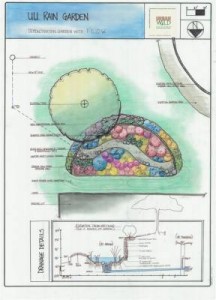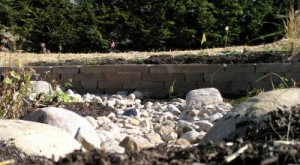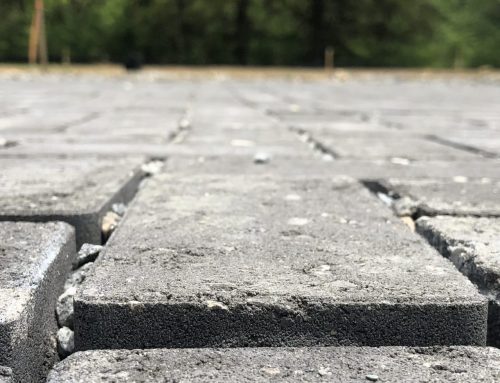Raingardens – A New Stormwater Management Tool
After over two decades of designing subdivisions, commercial sites and roadways in central Ohio, I thought I had mastered the art of stormwater design. Piping the runoff, with a little detention and water quality treatment, had always been a good recipe. It was fast and efficient, and getting stormwater to the rivers as quickly as possible, after all, had always been the main goal.
It took a while for the raingarden concept to catch on with me. At first, I wasn’t too impressed with the landscaped depressions that didn’t drain anywhere. I couldn’t envision how they would be anything more than a mere drop in the bucket in the overall stormwater management scheme. But I humored my raingarden friends, and in the process began to come around. Maybe draining stormwater into a system of “engineered” filters could remove pollutants as effectively as conventional methods. Maybe giving stormwater an opportunity to recharge the groundwater system, reducing nuisance flooding and hard costs along the way, would be beneficial as well. If we put some thought and effort into this concept, maybe raingardens could become an effective tool in managing runoff, pollution and construction costs.
When you get down to it, raingardens are nothing more than “sexy” bioretention filters anyway. But, that sexy part of raingardens (ornamental plants, dry streams, etc.) is important. In order for them to catch on as a mainstream stormwater management tool, they must provide aesthetic appeal. Equally important, however, is the ability to get them designed and constructed efficiently. If the design-build community could find ways to aesthetically and cost-effectively incorporate raingardens, in lieu of traditional landscaping, into site-scapes, we might be able to use them to make a positive difference in stormwater sustainability.
A Raingarden Opportunity
In March of 2012, when Heather Dean of FLOW (Friends of the Lower Olentangy Watershed) and I became aware of grants from MillerCoors and River Network to create stormwater sustainability demonstration projects, we jumped at the opportunity to create a raingarden project in the Olentangy River watershed… and we knew just the place to do it. Through another endeavor, we had become familiar with the First Unitarian Universalist Church in the Clintonville area of Columbus. They were good neighbors in the community, interested in environmental stewardship, and best of all, had a property that would allow a great demonstration raingarden to be installed. With the help of Amy Dutt of Urban Wild, Heather partnered with First UU to prepare a winning proposal (complete with a project budget and concept plan) and received one of the MillerCoors/River Network grants. The concept plan included a stone wall and native plant material, both of which blended with the surrounding landscaping, and a decorative “dry stream”. Winning this proposal was exciting for me. I’d be able to work with Amy, participate in the design and construction process, and see the raingarden concept develop first-hand.
Pre-Project Concerns
Although I was familiar with raingardens, I had never been involved in the design or construction of one before. A successful proposal and a concept plan were a good start, but there were also the issues of making it work hydraulically, and getting it constructed before winter. Those issues made me a little nervous. This project would require retrofitting an existing roof drainage/storm piping system and those types of projects did not always go smoothly. I didn’t know it at the time, but building this raingarden was going to require a monumental effort on the part of the church and the design team, and significant coordination and cooperation with Columbia Gas, Igel Construction and others. I didn’t know it at the time, but building this raingarden was going to be an educational experience.
Raingarden Sizing
 The location of the raingarden was a given. The green space on the north side of the First UU property had been a perfect spot from the beginning. Rainwater from the roof area was convenient, the location was highly visible to the surrounding neighborhood, and there was plenty of unencumbered area (or so we thought) to work in. Our first assignment, however, was to determine the size of the raingarden. Although there are easy equations to compute raingarden size based on rooftop area, this calculation wasn’t that straightforward. The configuration of the existing roof and pipe systems created a scenario where, if designed conventionally, we would have had either a very small garden, serving only a small part of the roof area, or a very large and expensive garden serving a much larger roof area. Neither option was consistent with our project goals and budget.
The location of the raingarden was a given. The green space on the north side of the First UU property had been a perfect spot from the beginning. Rainwater from the roof area was convenient, the location was highly visible to the surrounding neighborhood, and there was plenty of unencumbered area (or so we thought) to work in. Our first assignment, however, was to determine the size of the raingarden. Although there are easy equations to compute raingarden size based on rooftop area, this calculation wasn’t that straightforward. The configuration of the existing roof and pipe systems created a scenario where, if designed conventionally, we would have had either a very small garden, serving only a small part of the roof area, or a very large and expensive garden serving a much larger roof area. Neither option was consistent with our project goals and budget.
We settled on a unique design. Our approach was to construct a manageably-sized raingarden and take the entire roof area to it, but incorporate two major deviations from conventional raingarden designs. The first deviation was to inlet stormwater from the roof and pipe system into the raingarden via a sub-surface aggregate trench, immediately below and integral with the dry stream. This gave us some much-needed elevation difference and would allow for diffusion of the concentrated pipe system flows, keeping them from eroding the raingarden surface. The second deviation was to provide an overflow device, in an existing upstream manhole, that would allow excess roof runoff to bypass the raingarden when it reached capacity. This would keep the raingarden from being flooded out on a regular basis. Both of these deviations allowed us to protect the raingarden while also treating the first flush from the larger roof area. I hope these design deviations will serve as a model for future raingarden projects as well.
Raingarden Retrofitting – Expect the Unexpected
Retrofitting anything, especially when it’s old and background information is sketchy, can be a challenge. Our First UU Raingarden project would certainly prove that to be true. Before construction, we were aware that there would be conflicts with an existing irrigation system, but we had no idea that a 20-year-old gas service line would become our main roadblock. One of our project partners, Greenworks Ecological, had begun the garden excavation, but they had not been on the job for more than thirty minutes before the discovery of the gas service line in our work area brought everything to a complete halt. As it turns out, the line had been constructed improperly, which had made it impossible to locate prior to beginning work. Regardless, a muddy mess had been created in a very visible location, and we were stopped dead in our tracks.
I can’t say enough about the effort Amy Dutt put forth in helping the First UU Raingarden become a reality. In addition to donating her time for design and installation project management, she worked tirelessly to stay on top of, and resolve, any problems that arose. Amy’s coordination with gas company representatives paid off almost immediately. Columbia Gas became a willing partner in our project, relocating the gas service line in a very timely manner and at no cost to us. Without that, continuing the project may not have been possible.
*****
With the gas service relocation completed, we were left with one last hurdle — finding a licensed contractor to retrofit the existing manhole with the bypass device and construct the new pipe/aggregate trench system to and through the garden. Once again, Amy came through. She contacted her friend Joe Igel, who graciously volunteered his company to help us out. Igel Construction completed this last piece of the raingarden infrastructure, along with some of the remaining site grading, and did so in a timely and professional manner. As with the gas service relocation, this work was done at no cost to the project and allowed us to complete it well within our grant budget.
Raingarden Irony
Having completed the raingarden infrastructure, all that remained was installation of the interior stone wall, dry stream and raingarden plants. For a “normal” raingarden project, these steps would have been a major milestone, but for us it was no big deal. We had already overcome several hurdles and were in the home stretch. The raingarden gods, however, weren’t finished with our project yet — not without sending a little rain our way. Ironic, don’t you think, that after all that effort, we could not complete the final steps because the ground surface was too wet to work.
A few dry, late October days, however, allowed the wall, dry stream, and plants to be installed, and the First UU Raingarden became a reality on November 5, 2012. There are still a few minor items on the spring punch-list, but it looks great. If we can just get past one last irony, everything would be awesome. That last irony, of course, is the perfect weather we’ve enjoyed since completion. “Let it Rain” — we’d all like to see our new raingarden in action.
Final Thoughts
Being a part of the First UU Raingarden project was a great experience, not only from the knowledge I gained, but from the people I had the opportunity to work with. I was surprised at the level of cooperation we received from many parties. Cooperation that, in this economy, was unexpected. Although we were successful, I caution anyone who wants to retrofit a raingarden into any existing system. Expect the unexpected, and allow for unknowns, time delays, and additional costs.
With that said, I’m convinced that raingardens can have a prominent place in existing and new-build stormwater management systems. For new-builds, raingarden networks, if properly planned at the beginning of a project, can be a very useful tool. As with conventional designs, however, they must be strategically placed on, and interfaced with other elements of, the site. Raingardens are not appropriate in all soil situations, and should be kept away from building foundations, basements and heavily-trafficked areas. With those precautions in mind, raingardens can, in my opinion, be a viable stormwater management tool.
After over two decades, it is possible to learn something new.
Do you have an interesting rain garden project experience? Please share with us in the comments.
 Mr. Tribble is a Civil Engineering/Water Resources graduate of North Carolina State University, and has practiced in the central Ohio area for over 30 years. He has devoted much of that time to the design and analysis of stormwater management and erosion control facilities for new developments. Mr. Tribble has been employed by several of the leading consulting firms in central Ohio, and in 2003 founded Stormwater Consultants LLC. Today he is employed by CT Consultants in Columbus.
Mr. Tribble is a Civil Engineering/Water Resources graduate of North Carolina State University, and has practiced in the central Ohio area for over 30 years. He has devoted much of that time to the design and analysis of stormwater management and erosion control facilities for new developments. Mr. Tribble has been employed by several of the leading consulting firms in central Ohio, and in 2003 founded Stormwater Consultants LLC. Today he is employed by CT Consultants in Columbus.
Mr. Tribble developed an interest in stormwater management while taking a hydrology and hydraulics class at NC State, as he learned the theory behind the actions and reactions of a small stream at his boyhood home to rainfall and upstream development. Today, Mr. Tribble’s stormwater management toolbox includes “green infrastructure” techniques, as he strives for environmentally-friendly methods to blend the economics of growth and development with the sensitivity of natural systems.







